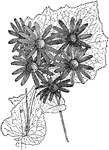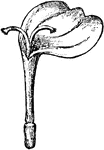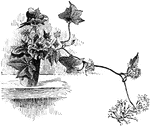Clipart tagged: ‘senecio’

Senecio Cruentus
This herb belongs to the canary islands, featuring flowers that look like daisy's. Flowers for this…

Groundsel
An illustration of a 1, disk floret; 2, same cut vertically; 3, ray-floret; and 4, fruit with pappus.
Disk-floret of the Senecio
An illustration of a disk-floret of the senecio flower. Senecio is a genus of the daisy family (Asteraceae)…

Disk-floret of the Senecio (Longitudinal Section)
An longitudinal section view of a disk-floret of the senecio flower. Senecio is a genus of the daisy…

Female ray-floret of the Senecio
An illustration of a ray-floret of the senecio flower. Senecio is a genus of the daisy family (Asteraceae)…

Gynaeceum of the Senecio
An illustration of the gynaeceum of the senecio flower. Senecio is a genus of the daisy family (Asteraceae)…






